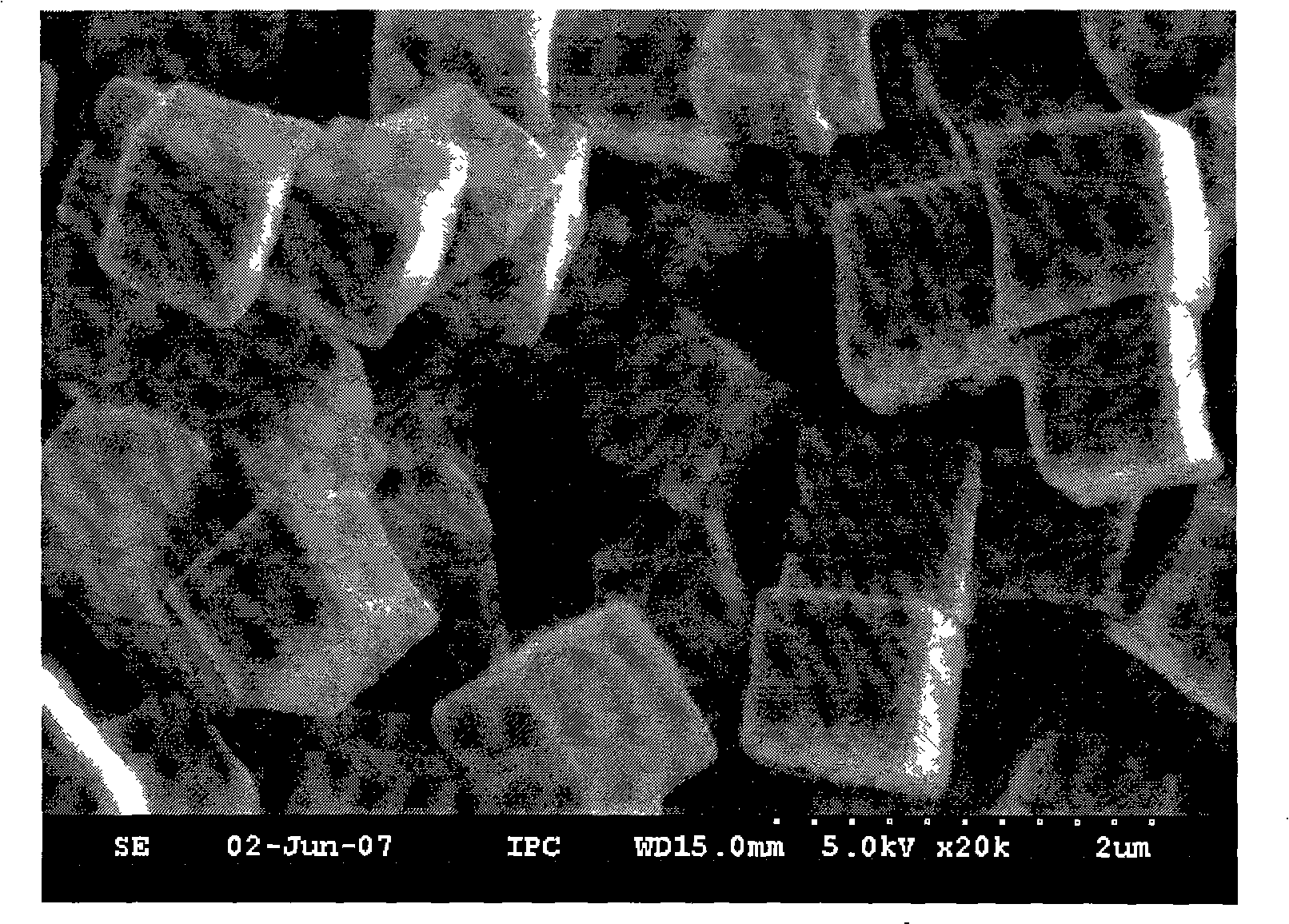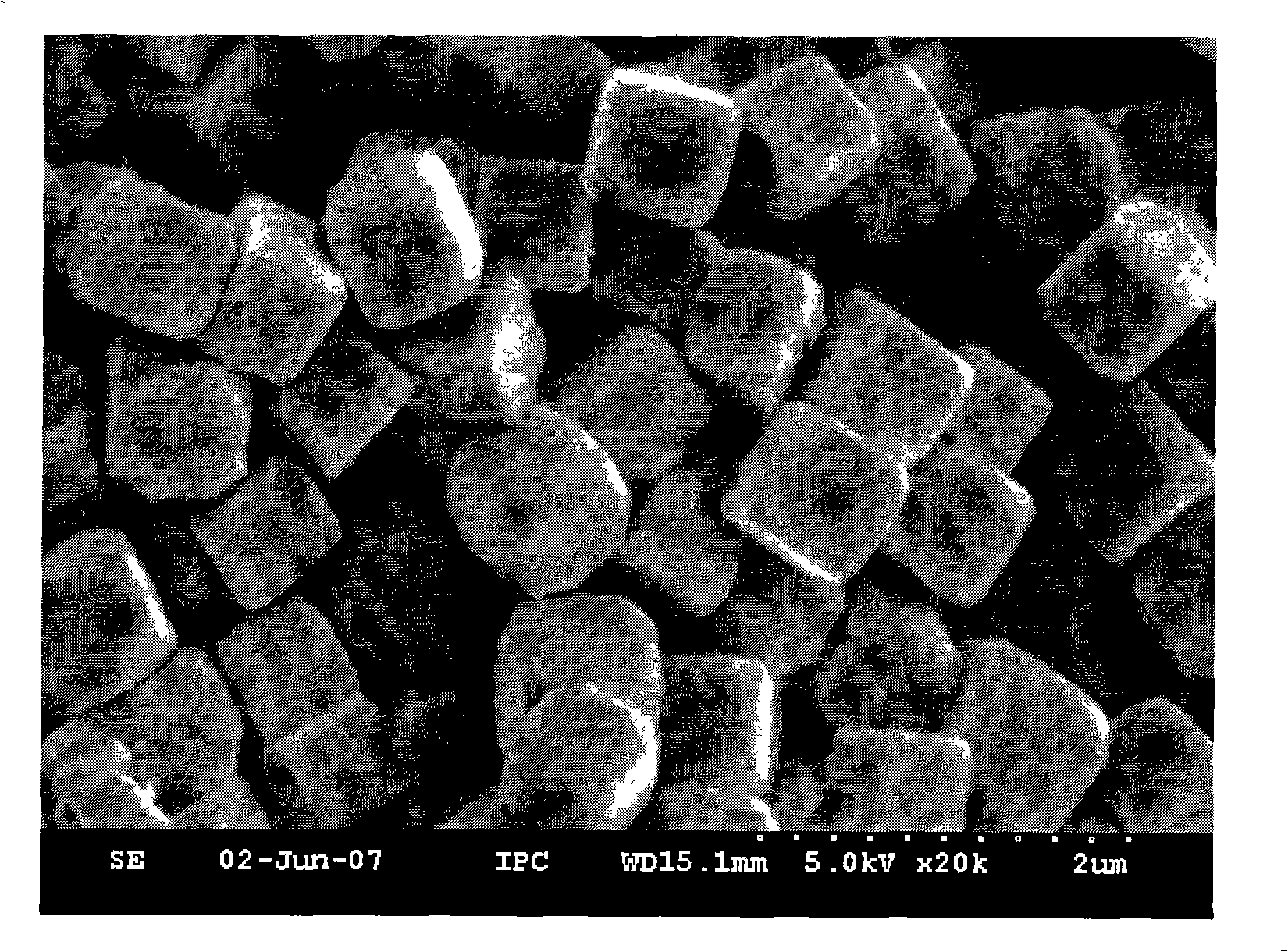Preparation of polyhedral cuprous oxide nano particle
A nanoparticle, cuprous oxide technology, applied in copper oxide/copper hydroxide and other directions, can solve problems such as unfavorable large-scale production, difficult synthesis control, complex conditions, etc., and achieve the effects of low cost, easy synthesis method, and simple operation.
- Summary
- Abstract
- Description
- Claims
- Application Information
AI Technical Summary
Problems solved by technology
Method used
Image
Examples
Embodiment 1
[0032] ① Preparation of strong alkali aqueous solution: Dissolve 1.2g of sodium hydroxide in 10ml of water, stir at room temperature to fully dissolve the sodium hydroxide in the water to obtain an aqueous solution of sodium hydroxide, the concentration of the aqueous solution of sodium hydroxide is 3.0mol / l.
[0033] ②Preparation of ascorbic acid aqueous solution: Dissolve 1.057g of ascorbic acid in 10ml of water, stir at room temperature to fully dissolve ascorbic acid in the water to obtain an aqueous solution of ascorbic acid, the concentration of the aqueous solution of ascorbic acid is 0.6mol / l.
[0034] 3. preparation of copper salt aqueous solution: in a 250ml flask, 0.171g cupric chloride is dissolved in 100ml water, and stirring at room temperature makes cupric chloride fully dissolve in water, obtains the aqueous solution of cupric chloride, the concentration of cupric chloride aqueous solution is 10×10 -3 mol / l.
[0035] ④Add 0.011g of polyvinylpyrrolidone to the ...
Embodiment 2
[0037] ①Dissolve 0.4g of sodium hydroxide in 10ml of water, stir at room temperature to fully dissolve the sodium hydroxide in the water to obtain an aqueous solution of sodium hydroxide, the concentration of the aqueous solution of sodium hydroxide is 1.0mol / l.
[0038] ②Dissolve 0.528g of ascorbic acid in 10ml of water, stir at room temperature to fully dissolve ascorbic acid in water to obtain an aqueous solution of ascorbic acid, the concentration of which is 0.3mol / l.
[0039] ③In a 250ml flask, dissolve 0.20g of copper sulfate in 100ml of water, stir at room temperature to fully dissolve the copper sulfate in the water, and obtain an aqueous solution of copper sulfate, the concentration of which is 8×10 -3 mol / l.
[0040]④Add 0.556g of polyvinylpyrrolidone to the flask, stir evenly at 55°C, add 10ml of the sodium hydroxide aqueous solution in ① dropwise, and continue stirring for 0.5h, then add 10ml of the ascorbic acid aqueous solution in ② dropwise, at 55°C Then stir ...
Embodiment 3
[0042] ①Dissolve 1.6g of sodium hydroxide in 10ml of water, stir at room temperature to fully dissolve the sodium hydroxide in the water to obtain an aqueous solution of sodium hydroxide, the concentration of the aqueous solution of sodium hydroxide is 4.0mol / l.
[0043] ②Dissolve 1.233g of ascorbic acid in 10ml of water, stir at room temperature to fully dissolve ascorbic acid in water to obtain an aqueous solution of ascorbic acid, the concentration of which is 0.7mol / l.
[0044] ③In a 250ml flask, dissolve 0.239g of copper acetate in 100ml of water, stir at room temperature to fully dissolve the copper acetate in the water, and obtain an aqueous solution of copper acetate, the concentration of which is 12×10 -3 mol / l.
[0045] ④Add 1.111g of polyvinylpyrrolidone to the flask, stir evenly at 55°C, add 10ml of the sodium hydroxide aqueous solution in ① dropwise, and continue stirring for 0.5h, then add 10ml of the ascorbic acid aqueous solution in ② dropwise, at 55°C Then st...
PUM
| Property | Measurement | Unit |
|---|---|---|
| length | aaaaa | aaaaa |
Abstract
Description
Claims
Application Information
 Login to View More
Login to View More - R&D
- Intellectual Property
- Life Sciences
- Materials
- Tech Scout
- Unparalleled Data Quality
- Higher Quality Content
- 60% Fewer Hallucinations
Browse by: Latest US Patents, China's latest patents, Technical Efficacy Thesaurus, Application Domain, Technology Topic, Popular Technical Reports.
© 2025 PatSnap. All rights reserved.Legal|Privacy policy|Modern Slavery Act Transparency Statement|Sitemap|About US| Contact US: help@patsnap.com



